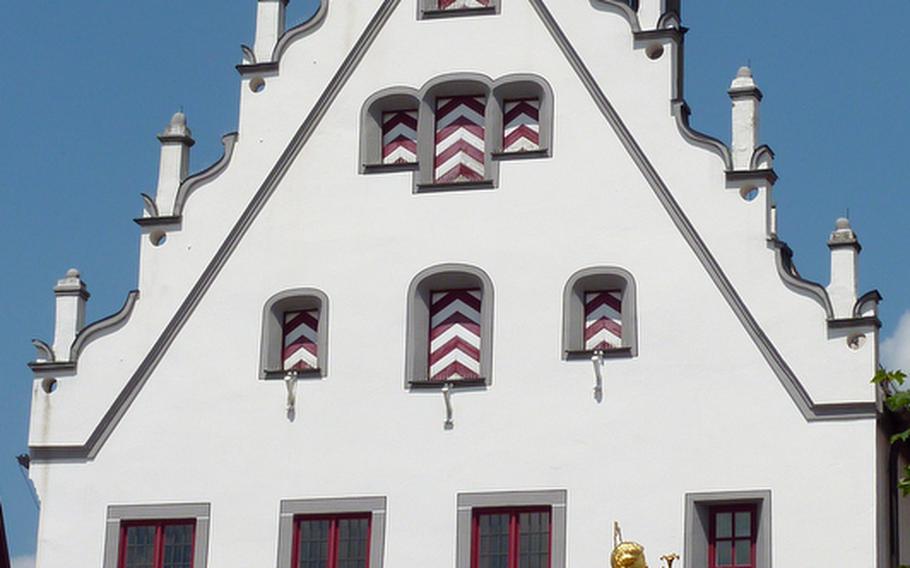
The Marktplatz in Wemding, Germany, is surrounded by many grand old buildings, such as the historical Rathaus (town hall). The golden Madonna statue stands in the center of the market square. (Michael Abrams/Stars and Stripes)
One of the highlights of travel in Germany is the Romantic Road.
From Würzburg to the Alps, the road passes by Rothenburg, Dinklesbühl, Nördlingen and King Ludwig’s fairytale castle, Neuschwanstein.
Although these might be the main attractions, just a couple of miles to either side of the road are plenty of other places worth visiting, and most have the advantage of not being so crowded.
Take Wemding and Oettingen, for example. Both towns are in or on the border of the Ries, an almost 25-kilometer-wide (or 15 ½-mile-wide) depression in the earth caused when a meteorite hit Earth 15 million years ago. Both towns have fewer than 6,000 inhabitants, and both are filled with historical houses encircled by medieval fortifications.
A statue with a sign beneath it greets visitors entering Oettingen through the Unteres Tor, or Lower Gate. The sign reads, “Be greeted guest of this city and explore what it has to offer.” A perfect suggestion.
Just past the gate is Schloßstrasse, the town’s main street that leads past the marketplace and the Rathaus, a grand half-timbered house.
Visitors should take note of an interesting aspect of the town: One side of the street features buildings of half-timbered architecture, while the other side features baroque.
Farther down the street sits a church that is worth a look inside before meandering to the 18th-century palace of the House of Oettingen.
From here, mosey through the lanes, past quaint squares and historic houses, stopping perhaps for a glass of what the town is best known for, Oettinger beer.
Wemding’s main claim to fame is that the German physician and botanist Leonhart Fuchs was born here in 1501. The fuchsia is named after him, and every year the town holds a colorful fuchsia and herb market.
But even without the market, the town is worth a visit.
Like so many old towns in Germany, the market square is its centerpiece. A fountain topped by a golden Madonna stands in the middle, and imposing baroque buildings surround the square.
Towering over it all is St. Emmeram church, its two towers rising 213 feet above the town. Check out the plaque on the Gasthaus zur Sonne. It notes that the Apollo 14 crew ate there in 1970. The crew underwent mission training in the Ries crater.
Fuchs’ birthplace is a narrow gabled house just off the square.
Wemding is one of those towns where one can simply enjoy strolling along tiny flower-clad squares, small parks and old fortifications.
While visitors can’t walk around on the wall as they can in Rothenburg, with its many towers and gates still standing, Wemding is worth the hike. Note the Folterturm, or torture tower, which got its moniker during the 17th century witch trials in Wemding.
On the outskirts of town, high on a hill, is the Maria Brünnlein basilica, a baroque pilgrimage church.
On the QT:DIRECTIONS: Oettingen is about 30 miles south of Ansbach, taking highway B13 and B466. Wemding is about nine miles farther south on B466. Wemding is about two hours east of Stuttgart on B29 and B25.
TIMES: The towns can be visited any time, but they are at their best in summer.
COSTS: It doesn’t cost a thing to see Wemding and Oettingen, and parking on the outskirts of the towns is free.
FOOD: Both towns have a bevy of restaurants, from traditional German fare to the ubiquitous Italian, in all price ranges.
INFORMATION: The towns’ German-only websites are: wemding.de and oettingen.de.
— Michael Abrams